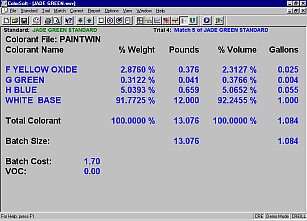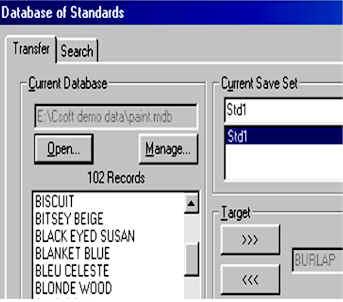Advanced ColorSoft®
|

|
The basic design of our advanced color matching programs has evolved from more than 30 man years of PC
color software development. Our design objective was to develop a master software set to:
- Control multiple instrument color
measurements
- Calculate color data and color QC
functions
- Create, manipulate and store color
data
- Calibrate colorants to allow a wide
range of
industries to formulate and correct colors
|
|
From the master program we provide
the ColorSoft user the tools to
build the system to meet their specific requirements. We provide both full systems with
all capabilities or limited software sets with one or more functions. Our full ColorSoft Windows program is offered as software modules:
|
- Basic System for Color Measurement, Data
Storage and QC Module
- Formulation & Batch Correction
Module
- Colorant Characterization Module
- Formula Storage Module
|

|
Spectrophotometer Measurement Control - senses the
instrument and its calibration condition, receives spectral data, allows averaging,
positioning of samples and identification of standard trials. The program is provided with
the special instrument interface communications protocol depending on the instrument
requirements. A variety of calibration techniques are provided in addition to the
instrument manufacturer’s recommended technique. |

|

|
Color Formulation Matching Module - Allows color matching by combinatorial match prediction using all
possible combinations from a full range of colorants or user selected colorants. Matches are sorted by cost and best color by single Illuminant or
by the
least metameric match. Allows
manual match and semiautomatic formula prediction using operator selected colorant
combinations from a range of colorants. Allows the addition of a waste batch as a new
colorant and correction of neares "SEARCH"candidate
from existing proven color match formulations.
|
Batch Correction Module - Predicts additions required to correct batch
from user entered formula or by automatic calculation based on colorants used. Also will
do automatic analysis of unknown batches and predict possible corrections. Provides
reformulation scaling for test batches to production batches. Includes manual add to
manually adjust batch and estimate results for batches and waste. Allows "reduction
of add " based on color tolerance. Provides functions to integrate corrections with
initial matches and save corrected formulas.
|

|

|
Colorant Characterization Module
Builds color matching K and S and/or K/S files that allow the user to characterize their colorants for matching and correction;provides 9 sample characterization methods, includes automated techniques for less experienced operators. Multiple Resins, bases, whites, substrates can be calibrated for specific colormetric functions in addition to colorants (dyes & pigments). The software simulates color letdowns on-screen. Allows colorant data base adjustment for new colorant batches and for quick check of colorant candidates for recycle. Multiple databases can be built to meet various application requirements.
|
| Color Library - Allows user to create one or more library
of color standards (Basic Module), with formula add on (Formula Storage Module). Allows search for closest matches and recall of formulas with color
standards. Offers a wide range of base to colorant options based on weight and volume
calculations. Searches can be based on any color criteria selected. Color Library is provided
in MS ACCESS format. |

|

|
| |
Color
Measurement- Color
instrument interface is supplied in the Basic
System Module and is required for all operations providing communication protocol to one or
more color instruments. ColorSoft is designed to communicate with a variety of color instruments, both Spectrophotometers and Colorimeters, via standard USB or RS232 serial interface.
The instrument drivers control
calibration logic, demanding calibration each time the instrument is
turned on (utilizing the instrument manufacturer’s methodology or other
optional methods); hold current calibration, initiate color measurements,
receive reflection or transmission data from the instrument, save the
data, allow averaging of 2 or more measurements into one measurement, run
diagnostics and perform electronic switching from one instrument condition
to another, if the instrument is designed to do so. |
We provide software to work with most color instruments that communicate 10nm and 20nm data via RS232 serial lines with user selectable 400 to 700
nm or 360 to 780 nm extended range.
ColorTec also supplies complete new systems working with the ColorTec "family" of color instruments and will mix software offerings for older color instruments as well as new
full systems.
|

|
Data Management offers
universal ODBC compatible (MS Access) data
management in a 64 bit Windows environment. We develop 4 types of data bases in our software.
The first is called a Saved Set; it contains a standard and multiple trials, including for each measurement, ID ( 40
character A/N), notes about the measurement, reflection data from the color measurements
stored as the instrument out-puts the data, in 10nm or 20nm spectral format.
From the
reflectance data the system calculates X,Y,Z, in 3 Illuminant weightings of the 14
illuminants offered in the basic software. 2 and 10 degree observer math is user
selectable. The colormetric calculation of choice is also stored with the record (we
currently support Hunter L,a,b, CIELAB, FMCII, CIELuv, XYZ/Yxy, CMC with settable ratio, Lch, CIE94 (CIEII) with settable K factors). These files are used to store and recall measurements for data
analysis, development of colorant files and for future formula prediction or correction. Save Set data is provided in the Basic System Module. |
The second database file type are Reflection Files (ODBC compatible) of unrelated color measurements with search functions. The structure of the color measurements are the same as
the Save Sets. Data can be moved from Reflection Files to Save Sets and back, on demand.
Often Reflection files are used to store Master Standards of data. Reflection Files are
useful to store fan deck colors with 2 fields of alpha numeric ID information, which
allows a color number in one field and a color name in the second field.
You can recall
from this file, or measure a color and recall one or more close colors. This type of field
is useful in storing competitive color decks, recalling them and running a match, without
having the competitive color available at
the site. |

|
The third type of
database files are Formula Storage Files (ODBC
compatible), which are files that allow you to store the
quantities of colorants and base materials in weight and/or volume which are proven to
produce a defined color measurement. This feature becomes a valuable asset as an
electronic formula book for your standard colors.
ColorSoft provides the tools
to tie a Formulation File to a Reflectance
File and to one or more a Colorant
files. Utilizing Search functions use this feature for a measure and search function. This
allows using the closest color as a match, or using the components of the closest color as
the staring point for a rematch.
Formulas can be recalled by ID and scaled to various
batch sizes, switched to weight and/or volume in a range of outputs (weight= ounces,
pounds, grams, Kilograms, grains ) (volume= ounces, settable shots, quarts, gallons,
millimeters, liters). Allows calculation of VOC if base data is entered in colorant file. Formula
Storage Files are included as part of the Formula Storage module. |
The fourth type of database file
are K and S, or K/S Colorant Files developed in our master system using the proprietary technology of the Colorant Characterization module.
For opaque materials ColorSoft has the logic to use samples
prepared using white bases and colorants based on using, black, and white mixtures; black,
white, and mass tone mixtures; a series of white let downs; and black with a series of
white letdowns and a mass tone mixture.
We can use one or more of the K&S colorant
calibration techniques in any one colorant file. Multiple colorant files are allowed, each
using separate colorant calibration tools.
For specialty Plastics, some Ceramics, some
Cosmetics, Cement and some Coatings applications, resins can be calibrated to take into
account the color contribution of the non colorant base portion of a mix.
Multi
concentration K/S Textile and Clear Ink colorant characterization and clear solution (or
clear film) mixing colorant characterization based on Beers Law are also supplied and
supported. |

|
System Logic is designed to allow the user and ColorTec support
engineer to set specific requirements for data analysis, color matching, colorant
calibration and color correction. The setup for data analysis can be done on a master
system while developing colorant data bases and organizing the system for the other
plants.
The systems sent to the other plants can then utilize colorant data bases
developed on the master system as long as the instrument metamerism is minimized. Changes
can be made in the field by sending new files or software updates to each of the locations. The satellite locations can purchase just the Basic QC module and the Formulation & Batch Correction module.
This allows development flexibility at the central lab and still maximizes
efficiency of sample preparation for plant support. If local plants still need the freedom
to use different colorants to meet local conditions they will need the ColorSoft Colorant Characterization module. |
Networking of Data and Operations is planned into the ColorSoft software design. We can install the software on single unit
systems, Local Area Networks based on Token Ring or Star configurations (Novell or NT) or
Peer to Peer LANS.
We also offer unique "Work Only" station licenses that can be
used to extend the use of your ColorSoft investment to allow multi applications using one color instrument with
multiple stations in the local plant. This allows the technician to do day to day work on
the main station and still allow you to recall color data or do other color operations at
a second station.
Some ColorSoft users use the
"Work Only" license on a portable computer to take color data to a customer for
review or to allow a remote modem call in to support plant operations trouble shooting in
off hours or while a key technical person is traveling.
|
Success of Color Formulation
Systems as measured by the accuracy and
repeatability of color matches is highly dependent on the quality of instrument, its light
source and the quality of the colorant calibration samples and the precision of sample
measurement procedure and the accuracy of the weigh ups including the precision and
minimum resolution of the weigh scales, the consistency and the quality of the formulation
prediction, rather than the software.
ColorTec’s objective is to optimize
our software matching results to provide the best match that each type of color instrument
is capable. If the database samples are well made, the color instruments of good quality,
the operator carefully measures the sample, you can expect color matches with color accuracy well below the visual threshold
with a ColorSoft System. On
going results are highly dependent on the color consistency of the materials used for
formula prediction and correction. |

|
ColorSoft® is a registered
trademark of ColorTec Associates, Inc., other manufacturers trade marks acknowledged; the
software is licensed for use of a single computer to the original purchaser, multiple
instruments are allowed. |

